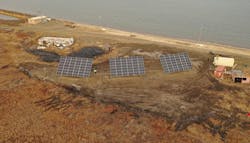Snowstorms, Remote Locale, and Practical Jokes Can’t Stop Alaskan Microgrid
A sudden snowstorm in a far Northwest arctic locale, sleeping in a laundromat (for no better place) and practical jokes were only some of the challenges facing Grass Valley, Calif.-based BoxPower in deploying a new solar/storage microgrid in the indigenous village of Deering in remote Northwest Alaska.
The installation is the second microgrid for the company in Alaska and second involving NANA, a regional corporation made up of 14,500 Iñupiat shareholders, or descendants, who live in or have roots in the region. The Iñupiat are people with close ties to the land and to each other, according to its website, and the word “Iñupiat” means “real people,” in its language.
Deering residents number 160 people that have seen their hunting patterns altered by climate change and had been burning about 46,000 gallons of diesel fuel a year to power their homes and other structures and facilities. They also face extremely high costs for food, electricity and freight, as well as low levels of employment.
The three solar/storage units installed by BoxPower are 16 kW each, for a total capacity of 48 kW being fed into the main grid, offsetting diesel generation, and enabling diesel generators to turn off during sunny and windy conditions. Wind turbines were previously installed in 2015.
The new installation had difficult supply chain logistics due to the remote location, but a breakthrough method of anchoring the systems to the ground led to big savings, according to Boxpower CEO Angelo Campus.
Cutting microgrid costs by near half
“We learned that logistics and supply chain are the most difficult part of Alaskan microgrids,” Campus said in a phone interview. He detailed lessons learned since the company’s first installation in Buckland, Alaska, another northwestern arctic city, in 2018. One of these was that a significant portion of the cost and construction time at Buckland came from building the foundation for the units.
This time around, the company found a way to minimize site preparation with 30,000-pound bags of sand and gravel placed on each unit, which avoided having to construct a foundation. The technological changes allowed installation of a system at about $4.50 per watt, compared with about $8 per watt for comparable projects in Alaska.
The Deering installation required an entirely different approach because of the difficult logistics compared with traditional installations in more friendly environments, Campus said. One of the challenges was getting equipment up to a remote location in weather conditions that are often harsh and amid winds that have been measured up to 145 miles per hour in the region. There is a four-week window in late June and July in which components for a power system can be shipped to such a remote northern location, according to Campus. The equipment was sent on barges, about a six-week trip, and two team members flew there two months later.
By comparison, usual lodging and support of construction crews for a system of this size requires five to six people working for three to four weeks, Campus said. The Deering installation took only about a week, which created additional cost savings.
Campus, who weathered similar conditions in the company’s first installation in Buckland in 2018, said that the local community in Deering was extremely friendly, bringing food and inviting two on-site Boxpower employees over for dinner.
“The community was incredible from that perspective,” Campus.
But one of two Boxpower team members, an electrician, got a dose of local humor when on his last day, a snowstorm prevented him from flying out. Too bad, the locals , said, that was the last flight of the season — he would be there all winter, they told him. That led to some panicked communication back home, but it turns out they were just kidding, and he was soon home-bound after all.
More Alaskan projects to come
Next up for BoxPower is a partnership with Tesla for another project in Alaska, Campus said, but he was mum on details.
“More to come on that,” he said.
Track news about microgrids throughout the world. Subscribe to the free Microgrid Knowledge newsletter.
